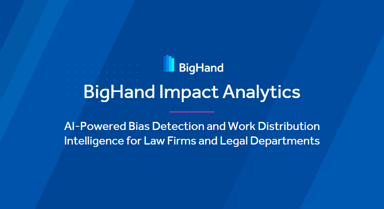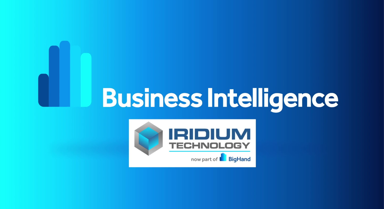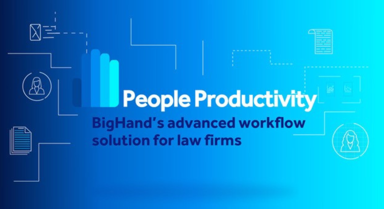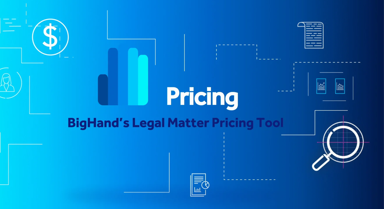Video Transcript:
Catherine Krow:
Thank you. Alright. Thank you for that kind introduction. I am Catherine Krow. I'm the founder of Digitory Legal. We are a cost analytics platform and service focused on data-driven pricing and cost management. And we are also proud to be a certified women-owned business, just like Buying Legal Council. But the most important thing I want you to know about me today is that I have a complete data geek. I am that way because I understand that nothing moves the needle faster and more effectively than actionable data.
Actionable. That is a really important modifier because not all data is created equal. So, when I talk about actionable billing data, it has a very specific meaning. Four attributes it is task level, activity level, and well-labeled data, that is accurately and consistently coded and connected to context. The why, because that is decision grade insight.
So today I'm going to be talking about how to get actionable data a little bit more about what it is and how to use it, but also why it's important. Because unlocking the insight, harnessing the power of data may take a little process change and there's got to be a good reason for that, and there is. Because that which gets measured gets managed, it gets improved, it can be predicted, and it can be changed. But you don't get to any of that really good stuff until you deal with this.
So historically, industry-wide data management practices, particularly around legal billing data have not been rigorous. And that means we as an industry have acquired what I call data debt. We got a lot of it, it doesn't tell you anything. And so if you try to run analytics on your data without first making sure it's well structured and clean, what you're really doing is putting lipstick on a pig. You may have a shiny dashboard but look under the hood and everything it says is meaningless and wrong.
Now, Galileo once famously said, “Measure what is measurable, and make measurable what is not so.” And I love that quote in part because today with technology we can measure the unmeasurable and legal billing data is the perfect example. Because this opaque, jumbled mess is what an industry-standard billing file looks like. It is dirty, it is poorly structured. If it was coded at all, it was done inconsistently and wrong and it was too high a level to tell you anything about value.
So to use a construction analogy, just to drive this point home, it's a little like being able to see the cost of a house without being able to see how many square feet there were, how many floors, how many bedrooms, how many bathrooms. Oh, and then somebody coded all your plumbing as drywall. The numbers not only don't tell you anything, but if you try to use it they will tell you all the wrong things.
Technology can help you unlock all of the insight within your time narratives, within your data, to tell you what you need to know to understand the value behind the numbers and make more informed spending decisions. And what you're seeing here is one visualization of actionable data, the activity level, and well-labeled. Now you want it to be activity level for a couple of reasons. First, that is the only way you're going to get insight into the scope and get activity-level benchmarks that can help you see the value, and measure success even when circumstances change. So maybe that deposition cost X the first time, but deposition #7 should cost less. And a way to anchor your spending when circumstances change and they will.
You also want this level of insight, to see staffing around your tasks, and this is really about two things. Quality, are you getting the high-level strategic resources where you want them. And efficiency, are you seeing low-cost resources being used where it makes sense and as the time being spent on these tasks is appropriate. Now I want to make two points around this before I move on and listen up because if you take nothing else from this, take these two takeaways. First, to get this insight, which you really need if you're going to have well-scoped alternative fee arrangements and budgeting budgets and pricing proposals, you have to have a data structure that is more detailed than the industry standard codes, sometimes known as the UT BMS codes, the ABA codes and litigation there are the L codes. So that's the granularity. The second piece is you can get all of this insight if your narratives are strong.
Now the other attribute is accurately and consistently coded. Your data needs to tell the truth. If you put three lawyers in a room and ask them to code the same task, they're probably going to code it three different ways. It is not unusual for a lot of time to be dumped or coded into one particular category in litigation. That's that big blue bar, it's L120. It is analysis and strategy and it is a disproportionate amount of your spend, that is not all that they are doing. So when you transform it you find that the metrics are actually very, very different. So you have to deal with this problem.
A note of caution here too, for those who want to scale data. The first rule of AI is garbage in and garbage out. So you have to make sure that before any data is used as a data set, as a training set, it is not coded by lawyers. You're not relying on that. It is coded expertly from scratch and with a plan. So that all your costs land in the same place every time, you can find them, and you know why.
The next attribute is of course connected to context, the why behind the numbers. And I do recommend surfacing this again from those time narratives, because what you think a case may be like at the beginning may not what it be, what it turned out to be at the end. So those attributes actually.
Now let's get to the how, how you use it, and the use cases. I like to do this with a construction analogy because when you think about it, complex work has a lot in common with a big construction project. If you don't scope it right from the beginning and monitor costs all the way along you will end up with a money pit. Now I like to take this make this analogy a little bit personal. So what you're looking at here isn't just a picture of any kitchen. That's my kitchen. And the reason you are looking at a picture of my kitchen is because I'm the only person I know, who has been through a massive remodel and still likes their contractor. And that isn't because nothing changed, of course, it did. It's because we didn't just take a time and materials bid, we had that bad boy scoped down to the nail. So that set clear expectations and accountability on both sides, and we were educated consumers before we started. So we could spot a lowball bid, and we had the information we needed to push back and get better value where it was appropriate. And your data can give you that level of education.
But the other most important reason is that we managed that, we tracked those costs at the activity level all the way through. So that when I walked into that kitchen and said, you know what, three pendant lights would look nice here. I didn't get some $15,000 surprise bill. That was a scope change. We all knew it. I got a number. I approved it and then they could get paid.
So your law firms, I know plenty of law firms that can do this level of managing for you and so if you're not getting it, ask for it. And for the for the law firms in the room, I'm going to extend this analogy just a little bit further. This contractor within six months had seven figures of referral work. Not because of the quality of the kitchen, like I like my kitchen and all, but just like the buyers in this room, quality of service is table stakes. It's assumed, the reason they got all that work was this. Deliver this for your clients and you will get more work.
That which gets measured can be predicted. I talk about this in terms of snowflakes because of the snowflake problem. The belief many lawyers have is that because every big case is unique, like a snowflake, it's impossible to predict the cost. Well, it turns out even snowflakes follow patterns. With actionable data, those patterns can emerge, and so you can in fact predict costs with an unprecedented level of precision.
One more point, because this is important. It's about change because that which can be measured can be changed and so when you take that big bucket of L120 and you sort out what is actually happening, are you going to find that your diverse lawyers are getting the same career advancing opportunities as your non diverse lawyers. Or will you find, for example, that senior women are doing a disproportionate amount of what's known as case administration. Because when you can see it, you can fix it. You can dig in and with all the industry leaders in this room, we can all do better. So thank you.






